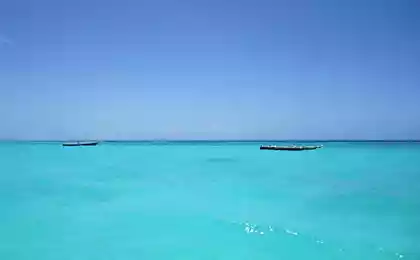971
The powerful tide - a huge tide
British photographer Michael Martin (Michael Marten) created a series of original images, retaining the British coast in the same angles, but at different times. One picture at high tide, and the other at low tide.
It turned out very unusual and positive feedback about the project, literally forced the author to do the release of the book. The book, called «Sea Change», was released in August of this year and was released in two languages. To create his impressive series of shots, Michael Martin (Michael Marten) took about eight years. The time between high and low water on average slightly more than six hours. Therefore, Michael has to stay in each place longer than a few clicks of the shutter time.
33 photos via masterok
1. The idea of creating a series of works by the author has long nurtured. He was looking for how to implement the change in the nature of the film, without human influence. And he found by chance in a Scottish seaside villages, where he spent the whole day and found the time tide.
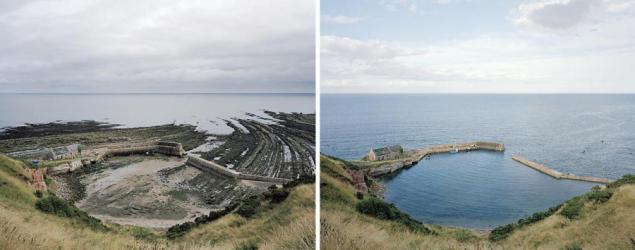
2.
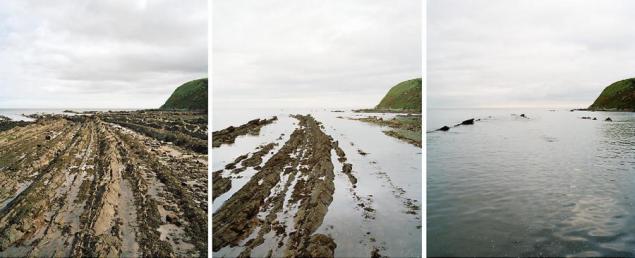
3. Periodic fluctuations in water level (ups and downs) in the waters of the world are called tides.
The highest water level observed for a day or half a day at high tide, the water is called complete, the lowest level at low tide - low water, and the time limit to achieve these benchmarks - standing (or stage), respectively the flow or ebb. Mean sea level - notional value above which there are benchmarks during high tides and lower - at low tide. This is the result of averaging large swaths term observations.
Vertical fluctuations in water level during the tides associated with horizontal displacement of the water masses in relation to the bank. These processes are complicated surges, river flow and other factors. The horizontal movement of water masses in the coastal area known as tidal (or tidal) currents, whereas the vertical oscillations of the water level - tides. All the phenomena associated with the ebb and flow, characterized by periodicity. Tidal flow periodically reverses, as opposed to ocean currents are moving continuously and unidirectionally, due to the general circulation of the atmosphere and cover large areas of the open ocean.
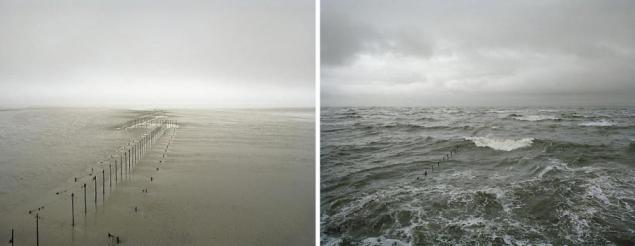
4. Tides cyclically alternate in accordance with the changing astronomical, hydrological and meteorological conditions. The phase sequence of the tides is determined by two maxima and two minima in the daily course.
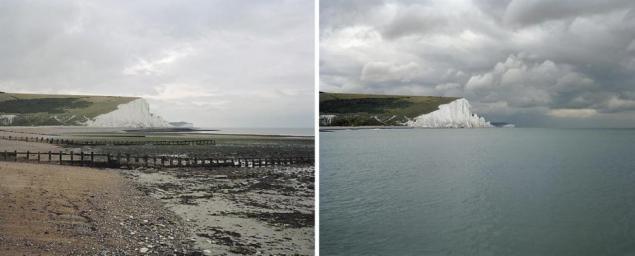
5. Although the sun plays an important role in the tidal processes, a decisive factor for their development is the force of gravitational attraction of the moon. The impact of tidal forces on each particle of water, regardless of its location on the earth's surface is determined by Newton's law of universal gravitation.
This law states that two particles of matter are attracted to each other with a force directly proportional to the product of the masses of the two particles, and inversely proportional to the square of the distance between them. It is understood that the more the mass of bodies, the more there is between the force of mutual attraction (at the same density smaller body will pull less than more).

6. Law also means that the greater the distance between the two bodies, the less the attraction between them. Since this force is proportional to the square of the distance back between the two bodies in the definition of tidal distance factor plays a much used? greater role than the mass of bodies.
The gravitational pull of the Earth acting on the moon and hold it in Earth orbit, the opposite of the gravity of the Earth's Moon, which tends to shift in the direction of the Earth to the Moon and "raises" all objects on Earth, in the direction of the moon.
The point of the earth's surface located directly under the moon, removed only 6400 km from the center of the Earth, and an average of 386,063 km from the Moon. Furthermore, the weight of the earth 81, three times the mass of the moon. Thus, at this point, the earth's surface Earth's gravity acting on any object, about 300 thousand. Times greater attraction of the moon.
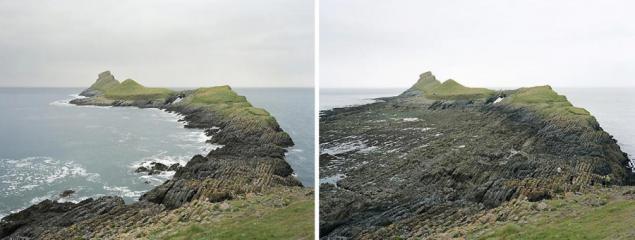
7. Distributed by the idea that the water in the world, located directly under the moon, the moon rises in the direction that leads to the outflow of water from other parts of the earth's surface, however, as the pull of the moon is so small compared to the Earth's gravity, it would not be enough to raise such a huge weight.
Nevertheless, oceans, seas and large lakes in the world, being large bodies of liquid, are free to move under the action of lateral displacement, and any slight tendency to shift horizontally sets them in motion. All waters that are not directly under the sun, governed by the component of the force of attraction of the Moon, directed tangentially (on) to the earth's surface, as well as its component directed outward, and are subject to horizontal displacement relative to the solid earth's crust.
The result is a flow of water from the surrounding areas of the Earth's surface towards the place under the moon. The resulting accumulation of water at the Moon forms a tide there. Actually a tidal wave in the open ocean has a height of only 30-60 cm, but it increases significantly when approaching the shores of continents or islands.
Due to the movement of water from neighboring areas in the direction of the point under the sun there is a corresponding outflow of water in the other two points distant from it by a distance equal to a quarter of the circumference of the Earth. Interestingly, lowering the level of the ocean at these two points it is accompanied by an increase in sea level, not only on the side of the Earth facing the moon and on the opposite side.
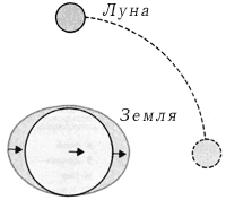
8. This fact is also explained by Newton's law. Two or more objects at different distances from the same source and subjected to gravity, thus speeding up the gravity of various sizes, are moved relative to each other as the closest to the center of gravity object most strongly attracted to him.
The water in the sublunary point feels a strong attraction to the Moon than the Earth beneath it, but the land, in turn, are strongly attracted to the moon than the water on the opposite side of the planet. Thus, there is a tidal wave that is on the side of the Moon facing the Earth is called the straight line, and on the other - back. The first of these is only 5% higher than the second.
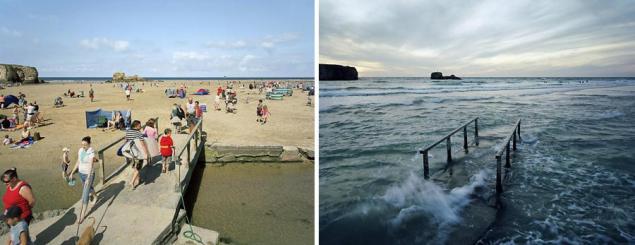
9. Due to the rotation of the Moon around the Earth in an orbit between two successive high tides and two low tides in a given place takes about 12 hours and 25 minutes. The interval between successive culminations tide approx. 6 h 12 min. The period of 24 hours 50 minutes between two successive tides called tidal (or lunar) days.

10. Inequalities quantities tide. Tidal processes are very complex, so to understand them, you must take into account many factors. In any case, the main features will be determined:
1) the development stage of the tide with respect to the passage of the moon;
2) tidal range and
3) type of tidal oscillations of the curve or shape the course of the water level.
Numerous variations in the direction and magnitude of tidal forces to generate difference values morning and evening tides in the port, and between the same tides at different ports. These differences are called inequalities quantities tide.
Semidiurnal effect. Usually during the day thanks to the main tidal force - the Earth's rotation around its axis - form two complete tidal cycle.
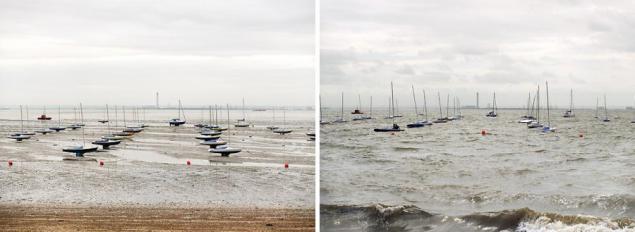
11. When viewed from the north pole of the ecliptic, it is obvious that the moon revolves around the Earth in the same direction as the Earth rotates on its axis - counterclockwise. Each next turn this point the earth's surface once again occupies a position directly below the moon a little later than in the previous turn. For this reason and tides each day delayed by approximately 50 min. This value is called the moon delay.
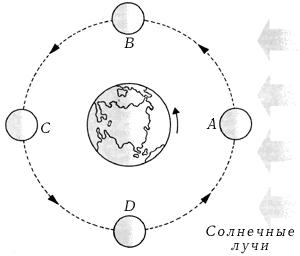
12. fortnightly inequality. This basic type of variations inherent periodicity of about 143/4 days, due to the rotation of the moon around the earth and the passage of its successive phases, in particular syzygy (new and full moon), ie, moments when the Sun, Earth and Moon are on one line.
So far we have only dealt with the impact of the tide-moon. The gravitational field of the sun also acts on the tides, however, although the mass of the Sun is much greater than the mass of the Moon, the distance from the Earth to the Sun is so superior distance to the moon, tide-generating force that the Sun is less than half of the tidal moon.

13. However, when the sun and moon are in a straight line like on one side of the earth, and on the other (in the new or full moon), the forces of attraction are formed, acting along one axis, and are superimposed on the solar lunar tide.
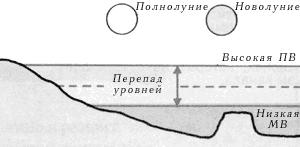
14. Similarly, the attraction of the sun increases the tide caused by the influence of the moon. As a result, hot flashes become higher and low tides is lower than if they were only caused by the attraction of the moon. These tides are called syzygy.

15. When the vector force of attraction of the Sun and Moon are perpendicular (at quadrature, ie, when the Moon is at first or last quarter), the tidal forces oppose them because the tide, caused by the attraction of the sun, is superimposed on the low tide, caused by the moon.

16. In such circumstances, the tides are not as high and low tides - is not so low, as if they were caused only by the force of attraction of the moon. Such intermediate tides are called quadrature.
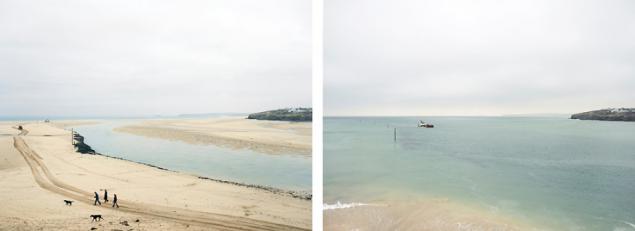
17. The full range of marks and low water in this case is reduced approximately three-fold compared with the spring tide.
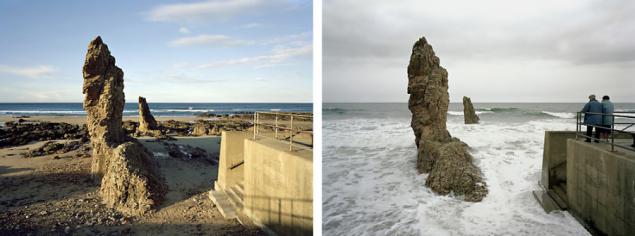
18. Lunar parallax inequality. The period of oscillation height of the tide, is due to the lunar parallax is 271/2 days. The reason for this inequality is to change the distance of the moon from the earth during the rotation of the latter. Because of the elliptical shape of the lunar orbit tide-generating force of the moon at perigee is 40% higher than at apogee.
Daily inequality. The period of this inequality is 24 h 50 min. The reasons for its occurrence - the Earth's rotation around its axis and change the declination of the moon. When the Moon is near the equator, the two tide in a given day (as well as two low tide) slightly different, and the height of the morning and evening full and low water are very close. However, with the increase in the northern or southern declination of the moon morning and evening tides of the same type differ in height, and when the moon reaches its maximum northern or southern declination, the difference is maximum.
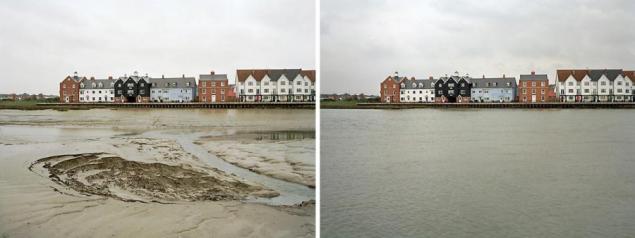
19. There are also tropical tides, so called because of the fact that the moon is nearly over the North or the South tropics.
Daily inequality did not significantly affect the height of the two successive tides in the Atlantic Ocean, and even its impact on the height of the tides is small compared to the overall vibration amplitude. However, in the Pacific Ocean daily non-uniformity manifests itself in levels three times as strong tides than in high water.
Semi-Annual inequality. Its cause is the revolution of the Earth around the Sun and the corresponding change in the declination of the sun. Twice a year, for a few days during the equinoxes, the sun is near the equator, ie its decline is close to 0. The moon is also located near the celestial equator for about a day every fortnight. Thus, at the time of the equinoxes, there are times when the declination and the Sun and Moon are approximately equal to 0. The total effect of the tide-gravity of the two bodies in such moments, most notably manifested in the areas close to the earth's equator. If at the same time the moon is in the phase of new or full moon, there are the so-called equinoctial spring tides.
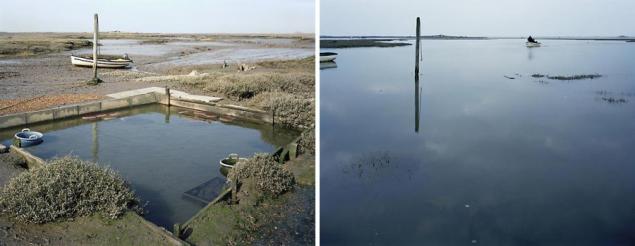
20. The solar parallax inequality. Period manifestations of this inequality is one year. His reason is the change in the distance from the Earth to the Sun in the course of the orbital motion of the Earth. Once during each revolution around the Earth the moon is at the shortest distance from it at perigee. Once a year, around January 2, the Earth, moving in its orbit, and reaches the point of closest approach to the Sun (perihelion). When these two points of closest approach are the same, causing the greatest cumulative effect of tide, you can expect higher levels of tides and low tides lower levels. Similarly, if passing aphelion coincides with the apogee, having less than high tides and low tides in shallower.
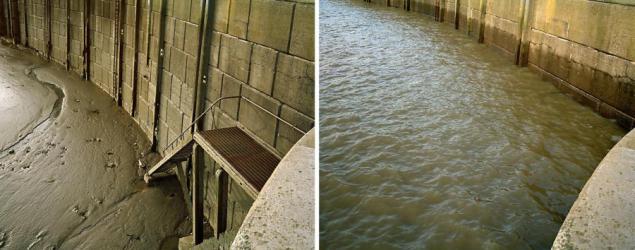
21. The greatest amplitude of the tides. The world's highest tide is formed under conditions of strong currents in the Bay of Minas in the Bay of Fundy. Tidal fluctuations are characterized by the normal course of a semi-diurnal period. Water level during high tide rises often six hours more than 12 m, and then over the next six hours is reduced by the same amount. When the impact of spring tide, the position of the Moon at perigee and maximum declination of the moon occur in one day, the tide level can reach 15 meters. This exceptionally large amplitude of tidal fluctuations partly due to the funnel shape of the Bay of Fundy, where the depth is reduced, and the banks converging towards top zaliva.Prichiny tide occurrence, having been the subject of ongoing research for centuries, are among the issues that gave rise to many conflicting theories, even in relatively recent times
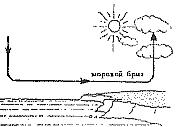
22. Charles Darwin wrote in 1911 .: "No need to look for ancient literature grotesque theories of tides." However, the sailors manage to measure their height and use of the tide, not knowing the real reasons for their occurrence.
I think that we may not particularly bother about the causes of the origin of the tides. On the basis of long-term observations for each point the waters of the earth calculated special tables which indicates the time of high and low water for each day. Plan your trip for example in Egypt, who was not known for its deep lagoons of podgadat try to advance so that the total water comes in the first half of the day, which will allow most of the daylight hours to fully roll.
Another issue associated with the tides for the kiter interesting, is the relationship of wind and water level fluctuations.
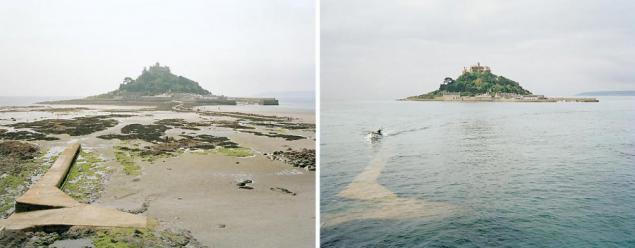
23. People sign argues that the tide and the wind increases to ebb contrary sour.
A more clear effect of wind on the tides. The wind from the sea catches the water toward the shore, tide height increases beyond normal, and at low tide the water level is also higher than the average. On the contrary, with the wind blowing from the land, the water drove from the coast, and the sea level is lowered.
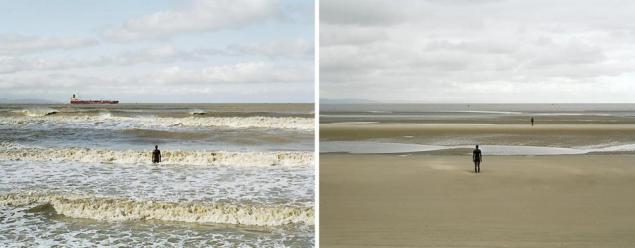
24. The second mechanism is by increasing the atmospheric pressure over a vast area, there is a lowering of the water level, as cash is added to the weight of the atmosphere. When atmospheric pressure increased by 25 mm Hg. Art., the water level is lowered by about 33 cm. The zone of high pressure or anticyclone is usually referred to the good weather, but not for the kiter. In the center of the anticyclone calm. Low atmospheric pressure causes a corresponding increase in the water level. Consequently, the sharp fall in atmospheric pressure, combined with hurricane force winds can cause a significant rise in water level. These waves are called tidal although in fact not related to the effects of tide forces and do not possess the periodicity characteristic of tidal phenomena.
But it is quite possible that the tides may have an impact on the wind, for example lowering of water levels in coastal lagoons, it leads to greater heating of the water, and as a result to a decrease in the temperature difference between the cold sea and heated land breeze which weakens the effect.
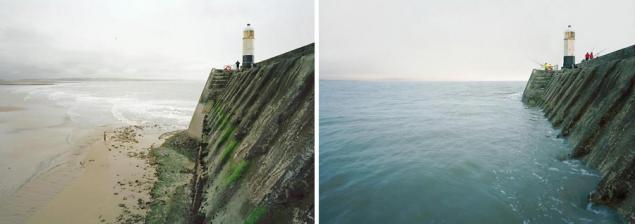
25.
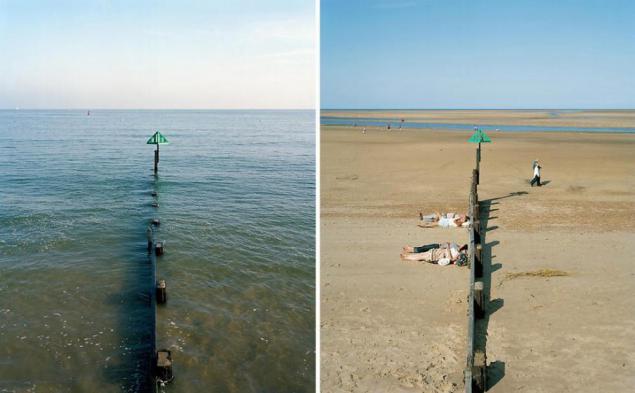
26

27

28
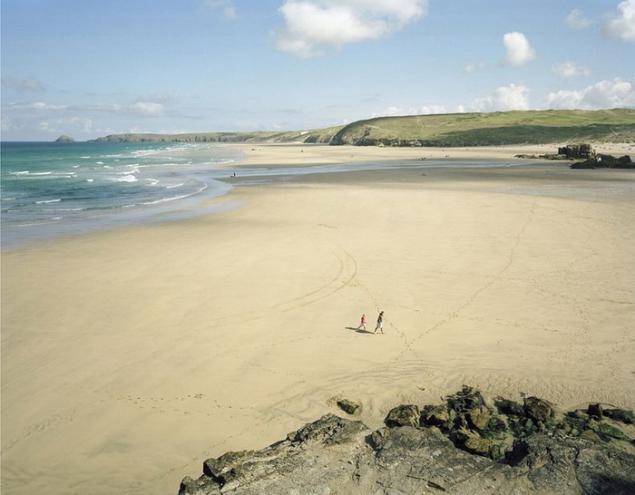
29
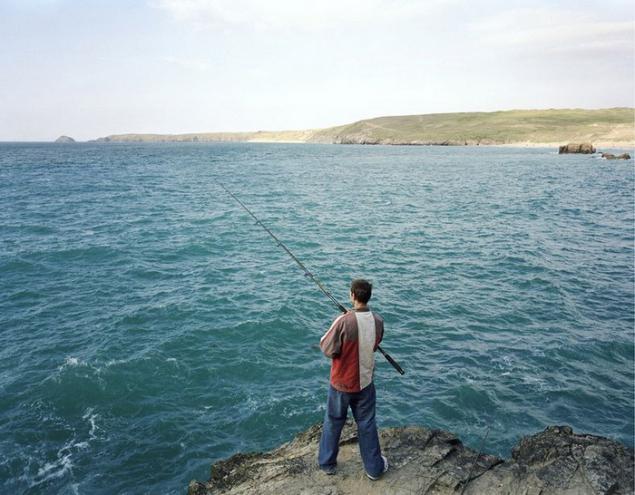
30

31
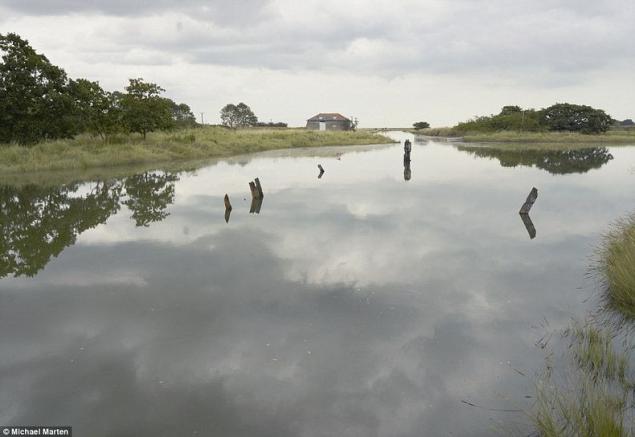
32

33

Source:
It turned out very unusual and positive feedback about the project, literally forced the author to do the release of the book. The book, called «Sea Change», was released in August of this year and was released in two languages. To create his impressive series of shots, Michael Martin (Michael Marten) took about eight years. The time between high and low water on average slightly more than six hours. Therefore, Michael has to stay in each place longer than a few clicks of the shutter time.
33 photos via masterok
1. The idea of creating a series of works by the author has long nurtured. He was looking for how to implement the change in the nature of the film, without human influence. And he found by chance in a Scottish seaside villages, where he spent the whole day and found the time tide.

2.

3. Periodic fluctuations in water level (ups and downs) in the waters of the world are called tides.
The highest water level observed for a day or half a day at high tide, the water is called complete, the lowest level at low tide - low water, and the time limit to achieve these benchmarks - standing (or stage), respectively the flow or ebb. Mean sea level - notional value above which there are benchmarks during high tides and lower - at low tide. This is the result of averaging large swaths term observations.
Vertical fluctuations in water level during the tides associated with horizontal displacement of the water masses in relation to the bank. These processes are complicated surges, river flow and other factors. The horizontal movement of water masses in the coastal area known as tidal (or tidal) currents, whereas the vertical oscillations of the water level - tides. All the phenomena associated with the ebb and flow, characterized by periodicity. Tidal flow periodically reverses, as opposed to ocean currents are moving continuously and unidirectionally, due to the general circulation of the atmosphere and cover large areas of the open ocean.

4. Tides cyclically alternate in accordance with the changing astronomical, hydrological and meteorological conditions. The phase sequence of the tides is determined by two maxima and two minima in the daily course.

5. Although the sun plays an important role in the tidal processes, a decisive factor for their development is the force of gravitational attraction of the moon. The impact of tidal forces on each particle of water, regardless of its location on the earth's surface is determined by Newton's law of universal gravitation.
This law states that two particles of matter are attracted to each other with a force directly proportional to the product of the masses of the two particles, and inversely proportional to the square of the distance between them. It is understood that the more the mass of bodies, the more there is between the force of mutual attraction (at the same density smaller body will pull less than more).

6. Law also means that the greater the distance between the two bodies, the less the attraction between them. Since this force is proportional to the square of the distance back between the two bodies in the definition of tidal distance factor plays a much used? greater role than the mass of bodies.
The gravitational pull of the Earth acting on the moon and hold it in Earth orbit, the opposite of the gravity of the Earth's Moon, which tends to shift in the direction of the Earth to the Moon and "raises" all objects on Earth, in the direction of the moon.
The point of the earth's surface located directly under the moon, removed only 6400 km from the center of the Earth, and an average of 386,063 km from the Moon. Furthermore, the weight of the earth 81, three times the mass of the moon. Thus, at this point, the earth's surface Earth's gravity acting on any object, about 300 thousand. Times greater attraction of the moon.

7. Distributed by the idea that the water in the world, located directly under the moon, the moon rises in the direction that leads to the outflow of water from other parts of the earth's surface, however, as the pull of the moon is so small compared to the Earth's gravity, it would not be enough to raise such a huge weight.
Nevertheless, oceans, seas and large lakes in the world, being large bodies of liquid, are free to move under the action of lateral displacement, and any slight tendency to shift horizontally sets them in motion. All waters that are not directly under the sun, governed by the component of the force of attraction of the Moon, directed tangentially (on) to the earth's surface, as well as its component directed outward, and are subject to horizontal displacement relative to the solid earth's crust.
The result is a flow of water from the surrounding areas of the Earth's surface towards the place under the moon. The resulting accumulation of water at the Moon forms a tide there. Actually a tidal wave in the open ocean has a height of only 30-60 cm, but it increases significantly when approaching the shores of continents or islands.
Due to the movement of water from neighboring areas in the direction of the point under the sun there is a corresponding outflow of water in the other two points distant from it by a distance equal to a quarter of the circumference of the Earth. Interestingly, lowering the level of the ocean at these two points it is accompanied by an increase in sea level, not only on the side of the Earth facing the moon and on the opposite side.

8. This fact is also explained by Newton's law. Two or more objects at different distances from the same source and subjected to gravity, thus speeding up the gravity of various sizes, are moved relative to each other as the closest to the center of gravity object most strongly attracted to him.
The water in the sublunary point feels a strong attraction to the Moon than the Earth beneath it, but the land, in turn, are strongly attracted to the moon than the water on the opposite side of the planet. Thus, there is a tidal wave that is on the side of the Moon facing the Earth is called the straight line, and on the other - back. The first of these is only 5% higher than the second.

9. Due to the rotation of the Moon around the Earth in an orbit between two successive high tides and two low tides in a given place takes about 12 hours and 25 minutes. The interval between successive culminations tide approx. 6 h 12 min. The period of 24 hours 50 minutes between two successive tides called tidal (or lunar) days.

10. Inequalities quantities tide. Tidal processes are very complex, so to understand them, you must take into account many factors. In any case, the main features will be determined:
1) the development stage of the tide with respect to the passage of the moon;
2) tidal range and
3) type of tidal oscillations of the curve or shape the course of the water level.
Numerous variations in the direction and magnitude of tidal forces to generate difference values morning and evening tides in the port, and between the same tides at different ports. These differences are called inequalities quantities tide.
Semidiurnal effect. Usually during the day thanks to the main tidal force - the Earth's rotation around its axis - form two complete tidal cycle.

11. When viewed from the north pole of the ecliptic, it is obvious that the moon revolves around the Earth in the same direction as the Earth rotates on its axis - counterclockwise. Each next turn this point the earth's surface once again occupies a position directly below the moon a little later than in the previous turn. For this reason and tides each day delayed by approximately 50 min. This value is called the moon delay.

12. fortnightly inequality. This basic type of variations inherent periodicity of about 143/4 days, due to the rotation of the moon around the earth and the passage of its successive phases, in particular syzygy (new and full moon), ie, moments when the Sun, Earth and Moon are on one line.
So far we have only dealt with the impact of the tide-moon. The gravitational field of the sun also acts on the tides, however, although the mass of the Sun is much greater than the mass of the Moon, the distance from the Earth to the Sun is so superior distance to the moon, tide-generating force that the Sun is less than half of the tidal moon.

13. However, when the sun and moon are in a straight line like on one side of the earth, and on the other (in the new or full moon), the forces of attraction are formed, acting along one axis, and are superimposed on the solar lunar tide.

14. Similarly, the attraction of the sun increases the tide caused by the influence of the moon. As a result, hot flashes become higher and low tides is lower than if they were only caused by the attraction of the moon. These tides are called syzygy.

15. When the vector force of attraction of the Sun and Moon are perpendicular (at quadrature, ie, when the Moon is at first or last quarter), the tidal forces oppose them because the tide, caused by the attraction of the sun, is superimposed on the low tide, caused by the moon.

16. In such circumstances, the tides are not as high and low tides - is not so low, as if they were caused only by the force of attraction of the moon. Such intermediate tides are called quadrature.

17. The full range of marks and low water in this case is reduced approximately three-fold compared with the spring tide.

18. Lunar parallax inequality. The period of oscillation height of the tide, is due to the lunar parallax is 271/2 days. The reason for this inequality is to change the distance of the moon from the earth during the rotation of the latter. Because of the elliptical shape of the lunar orbit tide-generating force of the moon at perigee is 40% higher than at apogee.
Daily inequality. The period of this inequality is 24 h 50 min. The reasons for its occurrence - the Earth's rotation around its axis and change the declination of the moon. When the Moon is near the equator, the two tide in a given day (as well as two low tide) slightly different, and the height of the morning and evening full and low water are very close. However, with the increase in the northern or southern declination of the moon morning and evening tides of the same type differ in height, and when the moon reaches its maximum northern or southern declination, the difference is maximum.

19. There are also tropical tides, so called because of the fact that the moon is nearly over the North or the South tropics.
Daily inequality did not significantly affect the height of the two successive tides in the Atlantic Ocean, and even its impact on the height of the tides is small compared to the overall vibration amplitude. However, in the Pacific Ocean daily non-uniformity manifests itself in levels three times as strong tides than in high water.
Semi-Annual inequality. Its cause is the revolution of the Earth around the Sun and the corresponding change in the declination of the sun. Twice a year, for a few days during the equinoxes, the sun is near the equator, ie its decline is close to 0. The moon is also located near the celestial equator for about a day every fortnight. Thus, at the time of the equinoxes, there are times when the declination and the Sun and Moon are approximately equal to 0. The total effect of the tide-gravity of the two bodies in such moments, most notably manifested in the areas close to the earth's equator. If at the same time the moon is in the phase of new or full moon, there are the so-called equinoctial spring tides.

20. The solar parallax inequality. Period manifestations of this inequality is one year. His reason is the change in the distance from the Earth to the Sun in the course of the orbital motion of the Earth. Once during each revolution around the Earth the moon is at the shortest distance from it at perigee. Once a year, around January 2, the Earth, moving in its orbit, and reaches the point of closest approach to the Sun (perihelion). When these two points of closest approach are the same, causing the greatest cumulative effect of tide, you can expect higher levels of tides and low tides lower levels. Similarly, if passing aphelion coincides with the apogee, having less than high tides and low tides in shallower.

21. The greatest amplitude of the tides. The world's highest tide is formed under conditions of strong currents in the Bay of Minas in the Bay of Fundy. Tidal fluctuations are characterized by the normal course of a semi-diurnal period. Water level during high tide rises often six hours more than 12 m, and then over the next six hours is reduced by the same amount. When the impact of spring tide, the position of the Moon at perigee and maximum declination of the moon occur in one day, the tide level can reach 15 meters. This exceptionally large amplitude of tidal fluctuations partly due to the funnel shape of the Bay of Fundy, where the depth is reduced, and the banks converging towards top zaliva.Prichiny tide occurrence, having been the subject of ongoing research for centuries, are among the issues that gave rise to many conflicting theories, even in relatively recent times

22. Charles Darwin wrote in 1911 .: "No need to look for ancient literature grotesque theories of tides." However, the sailors manage to measure their height and use of the tide, not knowing the real reasons for their occurrence.
I think that we may not particularly bother about the causes of the origin of the tides. On the basis of long-term observations for each point the waters of the earth calculated special tables which indicates the time of high and low water for each day. Plan your trip for example in Egypt, who was not known for its deep lagoons of podgadat try to advance so that the total water comes in the first half of the day, which will allow most of the daylight hours to fully roll.
Another issue associated with the tides for the kiter interesting, is the relationship of wind and water level fluctuations.

23. People sign argues that the tide and the wind increases to ebb contrary sour.
A more clear effect of wind on the tides. The wind from the sea catches the water toward the shore, tide height increases beyond normal, and at low tide the water level is also higher than the average. On the contrary, with the wind blowing from the land, the water drove from the coast, and the sea level is lowered.

24. The second mechanism is by increasing the atmospheric pressure over a vast area, there is a lowering of the water level, as cash is added to the weight of the atmosphere. When atmospheric pressure increased by 25 mm Hg. Art., the water level is lowered by about 33 cm. The zone of high pressure or anticyclone is usually referred to the good weather, but not for the kiter. In the center of the anticyclone calm. Low atmospheric pressure causes a corresponding increase in the water level. Consequently, the sharp fall in atmospheric pressure, combined with hurricane force winds can cause a significant rise in water level. These waves are called tidal although in fact not related to the effects of tide forces and do not possess the periodicity characteristic of tidal phenomena.
But it is quite possible that the tides may have an impact on the wind, for example lowering of water levels in coastal lagoons, it leads to greater heating of the water, and as a result to a decrease in the temperature difference between the cold sea and heated land breeze which weakens the effect.

25.

26

27

28

29

30

31

32

33

Source:

